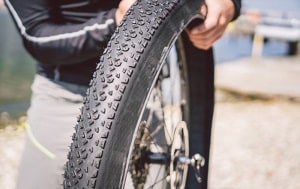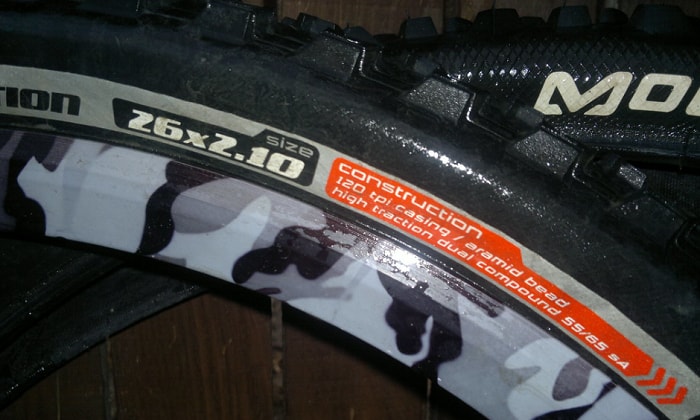Bicycle tires can have a bunch of numbers and letters on the side, but what is TPI in bike tires?
The letters TPI stand for threads per inch. TPI is a measurement of the cross-sectional density of threads that make up the sidewalls, tread, and bead area of a tire.
Basically, it is a number that defines the total amount of threads in one inch of a pneumatic tire. That’s it.
If you’re one of those people who have no idea what I’m talking about, continue reading to know about the bike tire TPI definition.
Table of Contents
What Does TPI Mean on Bike Tires?
TPI, or Thread Per Inch, is a measurement in the tires thread count- of how many and how closely the thread is wound together in every inch. For example, a tire with a 27 TPI has 27 threads woven into every 1 inch of the tire, and 120 TPI casing means it has 120 thread per inch.
This measurement has been around since the 1960s but has only become more popular over time.
The TPI number definition indicates how thick the threads will be, their puncture resistance, and how expensive the casing will be. The higher the TPI rating, the more threads can be placed in an inch.
A 120 TPI tire, for example, will be denser than a 60 TPI tire; however, the latter casing is thicker, making it more durable and resistant to puncture. The 120 TPI, on the other hand, is significantly lighter.
There are also other ways to find out about the TPI for your bike’s tires, but checking the manufacturer’s print on the side of the tire is the easiest way.
Material
Way before, tire manufacturers used cotton canvas for tire casing but different bike types became a hit thus TPI upgrades are a must. That is why other materials have come into play such as nylon, silk, kevlar, and aramid.
The threads are typically made from nylon or aramid fibers and they are made to be either thicker- but cheaper, or thinner and more flexible. They’re used for added strength and protection against flats during use.
What is TPI Used for?
TPI bicycle tires are very important for a bicycle’s performance on the road depending on the type of terrain or discipline the bike and its rider prefer. The thread patterning looks like a series of lines that run throughout the tire and can be stiff or flexible depending on the TPI.
In general, tires with more TPI feel more supple and give better traction — but not all tires have the same level of supple texture or traction ability. Choosing a higher TPI tire will be better if you frequent uneven roads and want better control or high performance.
If you prefer long-lasting tires and slow rides, then low TPI might just be for you. They are heavier but they are not susceptible to flat tires.
For instance:
- Road-bike tires: 120 TPI
- Downhill MTB tire: 60 TPI
How Does It Help Your Bicycle Tires Perform Better?
Choosing a TPI is one of the most common options available on bike tires.
It’s also one of the most important ones to consider when upgrading your bicycle tires — especially if you’re planning on tackling some serious terrain.
The thread count that makes up a layer of the tire is designed to improve the performance of your bicycle tires.
The lower the number, the stronger the tire will be, but at the same time, it is heavier since the threads are much larger in diameter and have more rubber. Also, the lower the value, the better the TPI puncture resistance there is due to the mixture of thick threads and rubber.
The higher the TPI rating, the thinner material (threads) there are for flexibility and performance. Hence, they are more supple and lightweight. The patented technology has been used to develop these high-strength materials, which are also lighter than traditional materials in older tires.
What is the Normal Range for TPI?
The normal range for a bike tire TPI is between 60 to 120 TPI. This is the most common TPI count for nylon casing that is usually used for road bikes.
But manufacturers can offer a wider range, and this value can go lower and even higher depending on the casing material. For instance, open casing with an inner tube, also known as clincher tires, sometimes uses cotton casing and can go up to at least 320 TPI, just like the Specialized Turbo Cotton and the Vittoria Corsa Tires.
Why Does TPI Matter?
If you wonder what the tire casing definition is, you may find out that this is the structure of a tire made of different layers, which include a layer of laid-out threads within a fabric in the technology- the TPI. This thin layer that is sandwiched in a bicycle tire offers great significance in a bicycle’s performance when you ride it out.
If you choose the proper TPI recommended for your bike discipline, you can ride safer and faster, and even keep the tires running for a bit longer. Each TPI technology has a recommended terrain use to help absorb impact and endure wear and tear to avoid frequently damaged tires.
FAQs
Is A Higher TPI Count Better?
If you are torn between 30 TPI vs 60 TPI, then you may want to list down a couple of things first before deciding on your bicycle tire.
It’s an important feature to look at when you’re shopping for new tires, as it can affect how your bike handles and rides.
Ideally, a higher TPI count of 320 and above are the best for mountain bike racing since it offers the best comfort and flexibility among the other TPIs. They may be expensive, but they are sure worth their money.
In terms of tire pressure, it depends on the tire width rather than TPI. So, it’s possible that 30 and 60 TPI tire pressure is the same if they are the same dimension.
What Is A Good TPI For Bike Tires?
MTB tires with a lower TPI value of at least 60 are perfect for downhill courses or any rough terrain with a high impact on the tires. They are more durable but easy to find on nylon casings.
On the other hand, lightweight and high puncture resistance tires like 120 TPI casing mean they are perfect for XC bikes and road bikes. It offers great speed and performance but can be heavy on the pocket.
Conclusion
What is TPI in bike tires? Are they just this thin layer, or does the technology behind them impact your driving more than you may expect?
It is one of the most straightforward or meaningful measurements out there, and it does speak to the general rigidity of the tire casing.
While you should not be making your purchasing decisions based on TPI alone, in the end: keep that TPI number in mind when evaluating bicycle tires.

“I ride my bike to work for years, but is that enough? Our carelessness towards our surroundings has taken a toll on the environment. And now, everyone is responsible for changes; even the most minor contribution is counted. With this hope and spirit, I started with my partner to establish Biketoworkday to help more individuals commute to their work sites on their bikes.”




